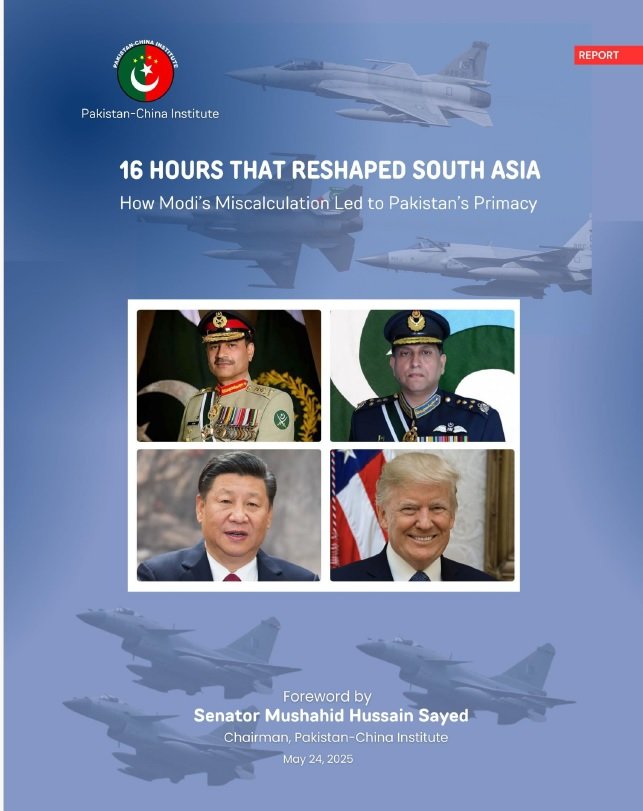
Report by globalnan.com
Foreword
Senator Mushahid Hussain Sayed sets the tone by referencing Lenin’s quote about rapid change occurring in moments of crisis. The document opens by calling the May 2025 conflict one of those pivotal episodes that reshaped South Asian geopolitics. He compares Indian Prime Minister Narendra Modi’s miscalculation to that of Nehru in 1962, suggesting India’s aggressive overreach resulted in a decisive defeat—military, diplomatic, and informational—at the hands of Pakistan.
According to the report, India sought to impose a “new normal” through coercive tactics along the Line of Control (LoC), but misjudged Pakistan’s resolve and military capabilities, leading to one of its most serious strategic setbacks since the 1962 war with China.
Background: The Scenario Before May 6, 2025
India held three core assumptions:
- Its conventional military superiority could neutralise Pakistan’s nuclear deterrence.
- The revocation of Kashmir’s autonomous status in 2019 had settled the Kashmir dispute.
- As a strategic partner of the West, particularly in the Quad framework, India saw itself as a regional hegemon positioned to counter China.
These assumptions unravelled throughout a 16-hour conflict, referred to as “Round I” (May 6–7) and “Round II” (May 9–10), that overturned India’s strategic calculus and reaffirmed Pakistan’s military credibility.
The Two-Phase Conflict: May 6–10, 2025
Round I: Initial Clash (May 6–7)
India’s attempt to assert air superiority backfired as the Pakistan Air Force (PAF) shot down six advanced Indian jets—three Rafales, two Su-30MKIs, and one Mirage-2000. This surprise loss inflicted a psychological and tactical setback on the Indian Air Force.
Round II: Counterstrike (May 9–10)
Following a second Indian strike on Pakistani locations on May 9, Pakistan responded with a well-coordinated missile and drone campaign that hit 26 Indian targets. The campaign involved:
- Electronic warfare and cyberattacks.
- Blinding Indian radars and disrupting command circuits.
- Stand-off munitions and precise targeting.
The technical superiority of Chinese military systems—such as sensors, jammers, and data links—played a key role in neutralising India’s French and Russian aircraft. Pakistan’s military command, led by Field Marshal Asim Munir and Air Chief Marshal Zaheer Ahmed Babar, executed a seamless joint operation that leveraged air, cyber, and missile warfare.
Diplomatic, Military, and Media Outcomes
Diplomatic Fallout
India found itself diplomatically isolated:
- The United States called for a ceasefire and treated both nations as equals.
- China supported Pakistan’s stance and escalated by rejecting India’s claim on Arunachal Pradesh (Zangnan), renaming 27 locations in the disputed territory.
- Russia, expected to back India, remained neutral.
Media and Narrative Warfare
India’s narrative—based on unverified claims of terrorist infrastructure in Pakistan—failed internationally. Conversely, Pakistan’s transparency, mature messaging, and factual disclosures resonated with the global community. India’s narrative, perceived as jingoistic and hyperbolic, alienated many, including its journalists.
Why Pakistan Won
The report attributes Pakistan’s success to:
- Unified military leadership and inter-service coordination.
- Superior operational readiness, particularly in night operations and terrain-based flying.
- Effective use of Chinese technology and integrated electronic warfare.
- A credible diplomatic campaign and stable, mature domestic media coverage.
National unity and public morale support the armed forces.
Modi’s Miscalculation and the Fall of ‘India Shining’
The report asserts that Modi misjudged Pakistan’s resolve and overestimated India’s military edge. The image of “India Shining” was tarnished by:
- Tactical defeat and failed coercive diplomacy.
- Rising domestic challenges include economic inequality, youth unemployment, and social unrest.
Global scepticism over India’s claims, amplified by public blunders in communication strategy.
New Strategic Realities in South Asia
- Restored Deterrence: Pakistan reestablished conventional deterrence, undermining India’s attempt to create a “new normal.”
- China’s Emergence: China solidified its role as a stabilising force and de facto stakeholder in Kashmir.
US Re-Hyphenation: The United States, by treating both countries as equals, nullified India’s ambition to be the unchallenged regional hegemon.
Strategic Significance and Way Forward
Global Implications
The battle exposed gaps in Western military assumptions about Chinese technology. Pakistan’s battlefield success gave pause to Western planners betting on India as a counterweight to Beijing. As a result, Islamabad strengthened its position as a leading Muslim Middle Power.
Revisiting Assumptions
The report likens Modi’s failure to historical blunders like Nehru’s 1962 war, Argentina’s 1982 Falklands fiasco, and Saddam’s 1980 misadventure in Iran. It argues that ideological arrogance and underestimation of an opponent are recurring themes in strategic failure.
Recommendations for Pakistan’s Strategic Future
- Seize the Moment on Kashmir:
- Leverage Trump’s ceasefire and mediation offer to internationalise the Kashmir dispute.
- Keep international pressure alive through diplomatic engagement and the media.
- Understand the Indian Ideological Landscape:
- Recognise that Modi’s government is driven by RSS ideology.
- Counter India’s 3D Strategy: Demonize, Damage, Destabilize Pakistan.
- Craft Strategic Clarity:
- Pakistan needs long-term clarity on India and Kashmir, emphasising resilience, consistency, and outcome-driven diplomacy.
- Maximize Global Influence:
- Use its tenure on the UN Security Council to spotlight Indian actions in Kashmir and elsewhere.
- Build stronger ties across the Global South and with traditional allies like China, Turkey, Iran, and Gulf nations.
- Narrative Warfare:
- Invest in global media outreach with credible English-language news outlets.
- Engage international think tanks, opinion leaders, and influencers.
- Domestic Cohesion:
- Capitalise on the national unity shown during the conflict.
- Avoid partisan politics that might dilute the momentum.
- Develop a comprehensive counter-terrorism framework to prevent future Indian-sponsored insurgency campaigns.
Conflict Timeline: April 22 – May 22, 2025
- April 22: Pahalgam attack kills 26 civilians. India blames Pakistan; Pakistan denies and suggests a false-flag operation.
- April 23–30: Diplomatic fallout, border closures, and initial skirmishes.
- May 1–5: Military build-up, diplomatic communications, and pre-emptive actions.
- May 6–10: Active combat phase: Indian attacks and Pakistan’s overwhelming retaliation.
- May 10–11: Trump mediates a ceasefire. Pakistan declares strategic victory.
- May 12–22: Post-conflict diplomacy, including Pakistan’s global outreach and India’s damage-control narrative.
Global Reactions
- China called India’s military occupation of Arunachal Pradesh illegal and supported Pakistan’s sovereignty.
- US: Proposed Kashmir mediation, breaking with its previous hands-off stance.
- Media and Experts: Global consensus recognised Pakistan’s military effectiveness and exposed Indian failures (CNN, Le Monde, New York Times, Financial Times, etc.).
- Professor Christine Fair & Pravin Sawhney (India): Criticised Indian media for jingoism and the government for strategic blunders.
Conclusion: Pakistan’s Finest Hour
The report frames May 2025 as a defining moment for Pakistan. It showcases not only military triumph but also strategic maturity, a unified national response, and elevated global standing. According to the report, this success was achieved not through aggression, but by decisively repelling Indian hostilities following international law and defensive doctrine.
The authors argue that India’s aggression was rooted in ideological extremism and hegemonic ambition, while Pakistan responded with professionalism, restraint, and clarity. The outcome, the report concludes, has redefined South Asia’s balance of power—temporarily halting Indian assertiveness and re-centering Pakistan as a key regional actor.

